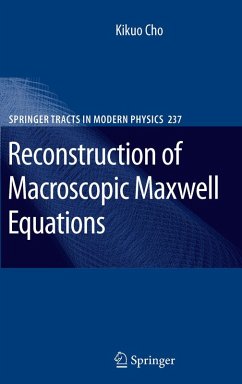This book presents a logically more complete form of macroscopic Maxwell equations than the conventional ones by applying long wavelength approximation to microscopic nonlocal theory. This scheme requires only one susceptibility tensor describing electric and magnetic polarizations together with their mutual interference. The quantum mechanical expression of the susceptibility covers both chiral and achiral symmetry. Only in the absence of chiral symmetry, this reduces to the conventional form, under the additional condition of using magnetic susceptibility defined with respect to, not H, but B. This scheme solves various problems inherent to the conventional scheme of Maxwell equations.
Dieser Download kann aus rechtlichen Gründen nur mit Rechnungsadresse in A, B, BG, CY, CZ, D, DK, EW, E, FIN, F, GR, HR, H, IRL, I, LT, L, LR, M, NL, PL, P, R, S, SLO, SK ausgeliefert werden.
From the reviews:
"The book under review is a specialized but at the same time a very interesting exposition on the Maxwell equations in matter or, in other words, on the response functions of matter to electromagnetic fields. It certainly is of interest to physicists working in condensed matter physics and optics, but also to scientists who want to learn more about some fundamental aspects of electrodynamics. Since the author applies his theory to metamaterials, the book could also catch the attention of scientists specializing in material science." (Marek Nowakowski, Mathematical Reviews, Issue 2012 a)
"The book under review is a specialized but at the same time a very interesting exposition on the Maxwell equations in matter or, in other words, on the response functions of matter to electromagnetic fields. It certainly is of interest to physicists working in condensed matter physics and optics, but also to scientists who want to learn more about some fundamental aspects of electrodynamics. Since the author applies his theory to metamaterials, the book could also catch the attention of scientists specializing in material science." (Marek Nowakowski, Mathematical Reviews, Issue 2012 a)

